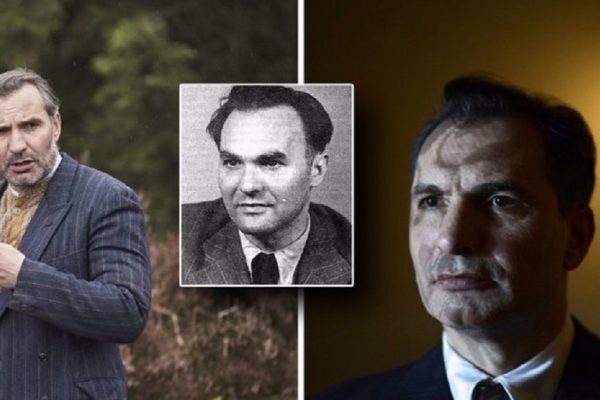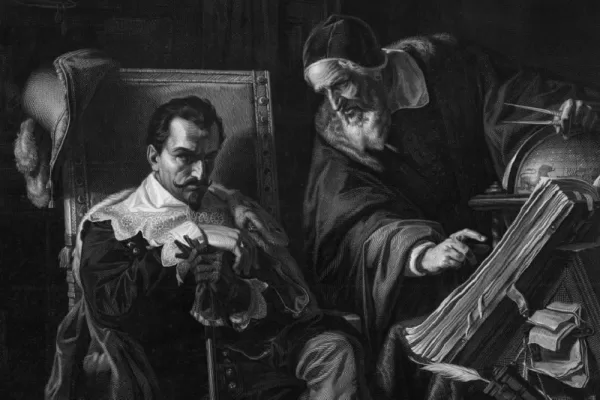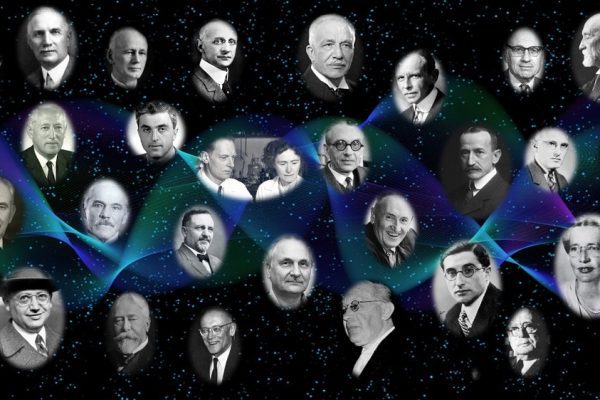The former First Lady Barbara Pierce Bush, the wife of President George H. W. Bush, is the 7th generation American, who descended from the Moravian Brethren family bearing the name Demuth.
Former First Lady Barbara Bush
Wife of 41st President and Mother of 43rd
Dies at age of 92
She was a Moravian
The Demuth family, who immigrated to America from Bohemia in the early part of the eighteenth century, had the distinction of being the charter members of the renewed Unitas Fratrum Church, later known as the Moravian Church (1). After the initial stay in Georgia, the members of the family settled permanently in Pennsylvania, and later several branches of the family moved to Ohio. Since then the family has greatly multiplied and its descendants are scattered throughout the U.S., not to speak of the branches that remained in Europe.
The first generations of the Demuths in this country played an important role as pioneer settlers and builders of the early Moravian settlements. By vocation and avocation they were farmers, carpenters, gunsmiths, merchants or teachers. Despite the generally antiwar stand of the Moravian Church, several members of the Demuth family distinguished themselves as soldiers during the American Revolutionary War, as well as the Civil War. In subsequent generations we find the Demuths practically in every profession, the number of physicians among them has been particularly high.
The Demuth’s tobacco shop in Lancaster, Pennsylvania, founded in 1770, is the oldest store of its kind in the United States and has been maintained by the family to date (2,3). Several members of this branch of the family were talented artists, especially Charles Demuth (1883-1935), who achieved national acclaim as a landscape artist (4, 5). Oliver James Demuth (1860-1912) entered politics, becoming county commissioner for Tuscarawas County, Ohio, state senator, mayor of New Philadelphia and later Ohio State Superintendent of the State Memorial Park at Schoenbrunn (6).
Genealogically speaking, there have been several attempts made to construct the family tree of the American Demuths, the most extensive being that of C.F. Buttershell (7) in his The Demuth Family and the Moravian Church. This attractive fifty-two-page booklet, published in 1931, is a combination of a family tree and a narrative. The early data were adopted from the genealogy chart of the Demuth family (8), compiled by Rev. Th. Mueller, archivist for the Records of the Moravian Church in Herrnhut, Saxony. In July 1941, Anna E. Gray, jointly with Donald S. Gray, prepared a typescript entitled “Demuth Family Tree” (9), based on the information gathered during the annual reunions of the local Demuth Association in Ohio. It is not a family tree in the usual sense but rather a compilation of names (without any vital data), each name having been assigned a composite number from which one can determine the place of a given individual on the family tree. Although the process is somewhat cumbersome, the compilation is, nevertheless, quite useful in furnishing names of the descendants in later generations, at least for some of the lines.
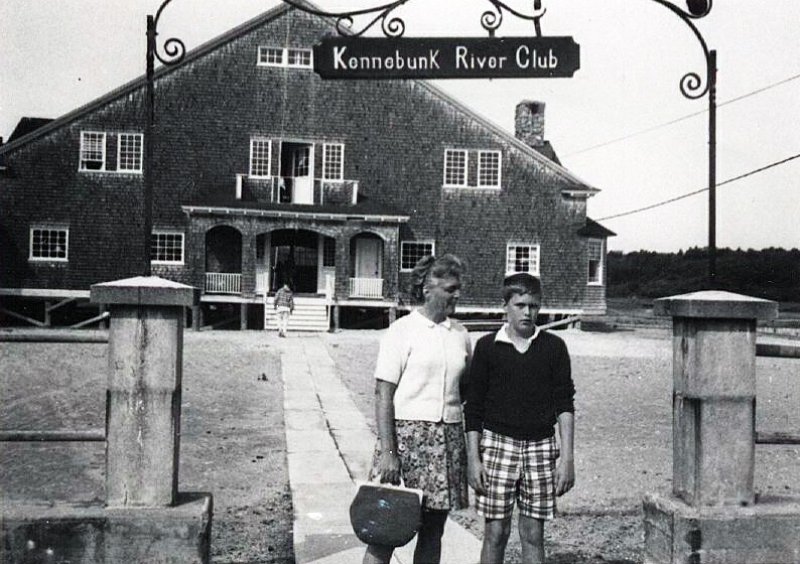
Jeb Bush with Barbra Bush in Kennebunkport, Maine August 1965 Photo Credit: George Bush Presidential Library and Museum.
More recently, Sarah Davies Hogeboom (10) began issuing a family genealogical journal, Sweet their Memories Are, which includes several sections devoted to the Demuth family. The chief value of this publication lies in the new genealogical data provided on the descendants of Wilhelm Gottlieb Demuth (1791-1882). The information has not, as yet, been brought up to date.
Most American Demuth lines originated either from Gotthard Demuth (1694-1744) or Gottlieb Demuth (1715-1776), the latter being the nephew of the former. On the close inspection of the data on Gotthard’s and Gottlieb’s descendants, as depicted in the published genealogies, referenced above, one is struck by one oddity, namely that Gottlieb Demuth is listed as having two sons, bearing the same given name, Christoph, one born in 1738 and the other in 1755. If the first Christoph would have died as a child, it would have been quite natural for the parents to give one of their later children the same name. However, in this case, the two Demuths lived, married, and both had children. Furthermore, as mentioned earlier, the older Christoph was born in the year of 1738, which is difficult to reconcile with fact that his presumed father Gottlieb married Christoph’s mother Eva Gutsler in 1739 or 1740.
In the effort to throw some light on these discrepancies; this writer has examined some of the early Moravian records and reconstructed the early history and genealogy of the Demuth family, which is the basis for the present paper. The main sources of my information were the manuscripts written by Rev. George Neisser (11). the first diarist of Bethlehem, who kept meticulous notes of the happenings and events of the early Moravians after they emigrated to Herrnhut and later to America.
An extremely useful source was also the rather rare publication of Dr. Felix Moeschler (12), entitled Die alte Herrnhuter Familien, a fairly reliable source of information on the Moravian and Bohemian emigrants, based on authentic church records and archival material in Herrnhut.
The Ancestral Home
The oldest known ancestor from whom most of the American Demuth lines rose, was Christoph Demuth, purportedly a magistrate in Karlov (Karlsdorf), Bohemia, a province of today’s Czech Republic. Originally, however, he presumably came from Šanov, Moravia, where his two oldest children were also born.
Some publications state that he lived in Carlsdorf, also spel1ed as Handelsdorf or Kathelsdorf, while, others give Karlsdorf, Handelsdorf or Radelsdorf, Bohemia as his home. All the authors agree on one point, however, namely that the community cannot be located on any modern or contemporary map.
According to the official Czechoslovak historical gazetteer (13) the community Karlsdorf, as it should properly be spelled, is identical with the village known under the Czech name Karlov. I was originally under the impression that this village was located in the Krnov District in Moravia but, after reexamination of all the existing facts, I came to the conclusion that his village is located, what, in 1850, was known as Šilperk District. During 1869-1910 it was part of the Zábřeh District and subsequently renamed Moravský Karlov. During 1921-1930 it was still an independent village (“obec”) but in 1950 it became a part of the village Bílá Voda in the Zábřeh District. Since 1951 it was attached to the village Červená Voda in the Ústí nad Orlicí District. Considering these changes and the fact that the community is rather small, and that there are a number of other villages with the same name, it is not surprising that it could not be easily located on a conventional map.
It is not known exactly when Christoph Demuth was born or when he actually died. The information about his wife, whose maiden name is not known, is equally scanty. What we do know are the names of his five children, i.e., Tobias, Justina (14), Christoph, Gotthard, and Maria Magdalena.
The family was nominally Catholic, of the “Hidden Seed” (15), who, for conscience sake and personal persecution, chose to flee from their homeland to seek refuge in Herrnhut, a newly organized Bohemian Brethren haven in Upper Lusatia, Saxony on the estate of Count Nicholas Ludwig van Zinzendorf.
The Herrnhut Exiles
The first of the Demuth family to leave for exile in Herrnhut (in 1725) was Christoph Demuth’s second oldest son Christoph, his oldest son Tobiáš having died in 1715. A few weeks later, Christoph returned to Moravia for his wife and his children. He and his wife, Anna Maria Schmidt, were participants at the first celebration of the Holy Communion in the parish church of Berthelsdorf on August 13, 1727. This was a memorable event marking the beginning of the Renewed Church of the Brethren. In 1728 the Demuths were joined in exile by Christoph’s third son Gotthard, and Christoph’s oldest daughter Justina.
Their sister-in-law, the widow of Tobiás, Rosina (Tonn) Demuth, came to Herrnhut in 1729, after managing to escape from prison in Moravia where she was held for over a year. She apparently came to Herrnhut together with her daughter Veronica. The remaining children of Tobiáš and Rosina Demuth, i.e., Joseph, (Anna) Veronica, Anna Maria and Gottlieb, were brought out of Moravia in 1730 by their uncle (Johann) Christoph Demuth. They were also accompanied by (Johann) Christoph Demuth’s sister, Maria Magdalena (Demuth) Wetzel, and her children.
While in Herrnhut, Gotthard Demuth married, in 1727, Regina Leupold, a daughter of George Leupold, whose family emigrated to Herrnhut in 1727 from Mladkov, Bohemia.
Veronica (or Verona) Demuth, the oldest daughter of Tobias and Rosina, was married twice, first in 1738 to Valentine Loehans, who died in 1742, and secondly in 1743 to Johann Boehner.
Joseph Demuth, a brother of Veronica, married in 1738 Judith Schaul, and their sister, Rosina Demuth, married an individual bearing the surname Hinz.
The remaining daughter of Tobiášs and Rosina, Anna Maria Demuth, was a woman of rare spiritual gifts who lived with the family of Count Zinzendorf and was ordained Deaconess. In 1738 she married Rev. A. A. Lawatsch with whom she served in various offices and places, in the capacity of spiritual adviser or general “Elder” of the female portion of the Church.
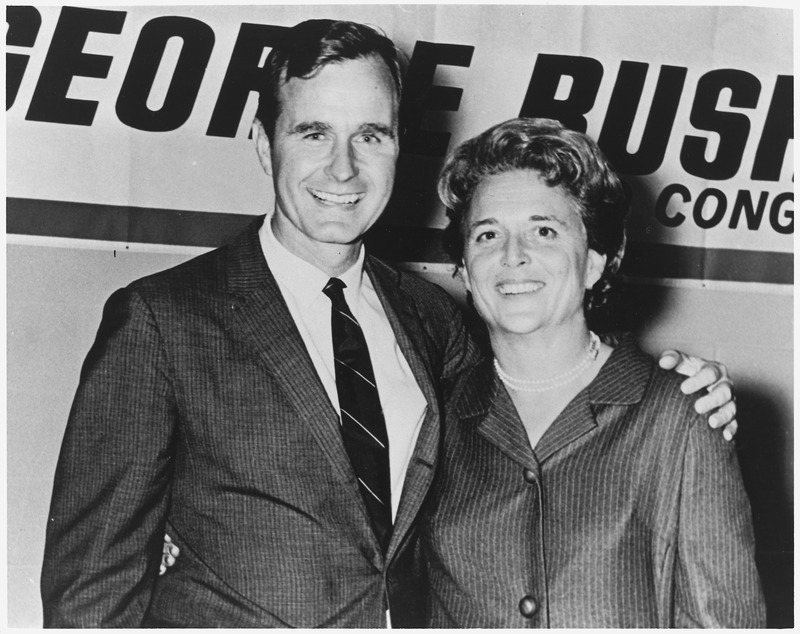
George and Barbara Bush in Houston, Texas on the night which George Bush was elected to Congress.
American Settlers
The first Demuth to step on the American soil was Gotthard Demuth (1694-1744) who sailed in a group of ten selected Brethren in November 1734 to the English Province of Georgia for the purpose of colonization. The vessel “Two Brothers” commanded by Capt. Thompson arrived off Savannah on March 22, 1735. The Moravian Brethren who arrived with Demuth were Augustus G. Spangenberg, Anton Seyffert, John Toltschig, Gottfried Haberecht, Peter Rosa, Michael Haberland, George Haberland, Frederic Riedel and George Waschke. With the exception of Spangenberg, all were natives of the Czech Lands.
Gotthard Demuth’s wife, Regina (Leupold) Demuth (1702-1774), followed a year later, arriving off Savannah on the “Simmonds” on February 16. This vessel brought altogether 25 persons, the majority of whom came either from Bohemia or Moravia, including Gotthard Demuth’s nephew, Gottlieb Demuth (1715-1776), and David Nitschmann (1696-1772), the first Bishop of the Renewed Unitas fratrum Church – the Moravian Church. Among the passengers on the ship which brought the Moravians to Georgia was also John Wesley, the founder of the Methodist Church, who became acquainted with the Brethren, attended their services, worshiped with them, and lived in their home during his initial stay in Georgia.
The stay of the Moravians in Georgia was not a happy one and led early to their decision to leave for Pennsylvania where they settled permanently. Seven of the colonists, including Gotthard Demuth and his wife Regina, left Georgia in 1737 and settled in Germantown, while Gottlieb Demuth moved to a new settlement in Matetsche, PA..
The next Demuths to come to America were (Johann) Christoph Demuth (1689-1754) and his wife, Anna Maria (Schmidt) Demuth (1697-1761), who sailed together with the other members of “The Second Sea Congregation” on “The Little Strength,” arriving in New York on November 26, 1743. They settled in Bethlehem, becoming members of the “Moravian Economy.” (Johann) Christoph Demuth died in Nazareth, PA and his name appears on a monument along with other names, giving the date of his death as March 5, 1754.
Gottlieb’s sister, Anna Maria (Demuth) Lawatsch (1712-1760), and her husband, Rev. Andrew Anton Lawatsch (d. 1771), sailed to America on the vessel “Irene,” arriving in New York City on May 17, 1751. She died on January 20, 1760 and is buried in the Old Moravian Cemetery of Bethlehem.
The oldest sister of Gottlieb, Veronica (Demuth) Boehner (1706-1765), who died at St. John, W.I., must have lived in Pennsylvania at least temporarily, considering the fact that two of her children, Paul Boehner (1745-1748) and Elizabeth Boehner (1751-1761), were buried in Bethlehem and another child, John Frederick Boehner (1745-1791), was buried at Nazareth.
There is also a record of the burial at Bethlehem of Agnes (Demuth) Loesch (1749-1832), a daughter of Gottlieb’s brother Joseph Demuth, the wife of a missionary, George Matthew Loesch (1750-1831).
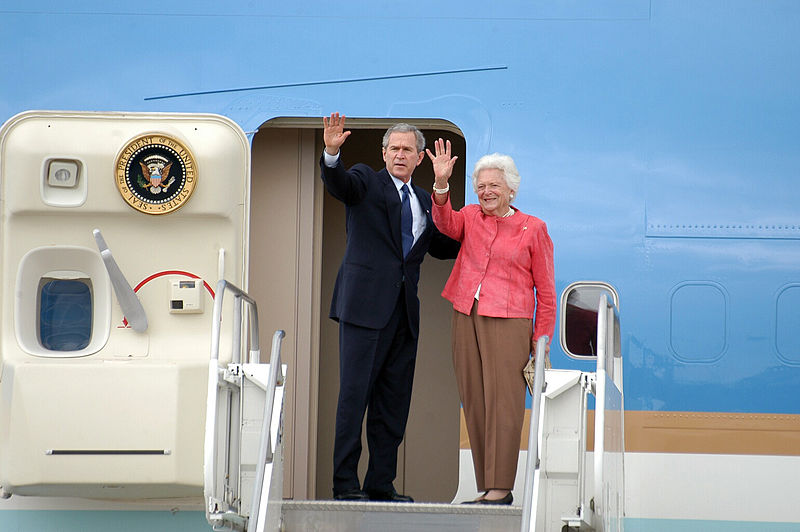
President George W. Bush and his mother, Barbara Bush, wave goodbye to a crowd of over 200 Sailors and Marines aboard Naval Air Station (NAS) Pensacola, Fla.
The Family of Gotthard and Regina Demuth
Based on Neisser’s List of the Bohemian and Moravian Emigrants to Saxony and Rev. Th. Mueller’s Family Tree, it is certain that Gotthard and Regina Demuth had at least one child, bearing the name Maria Magdalena (1731-1778), while living in Herrnhut. Dr. Pelix Moeschler in his Herrnhuter Familien lists actually four children who were born to them in Herrnhut, i.e., Maria Magdalena (1729-?), Magdalena (1731-1778), Johanna Elisabeth (1732-?) and Johannes (1734-1737). The stated year of Magdalena’s death (1778) is suspect since it is hard to imagine that her mother Regina would have emmigrated to America in 1736, leaving her five-year-old daughter behind.
From Neisser’s List, as well as Moeschler’s Herrnhuter Familien, it is quite clear that Gotthard and Regina had two more children after coming to America, namely, John Christoph (born September 19, 1738) and Christian Frederick (born December 26, 1740). Most records indicate that the two sons were born in Germantown, Pennsylvania.
Both Christoph and Christian were enrolled, in 1745, in the Moravian School for little boys in Frederick Township, as recorded by Rev. Abraham Reincke in his “Register of the Moravian Church”. According to this source, the two boys were born in Germantown and both were clearly identified as being the sons of Gotthard and Regina Demuth.
Gotthard Demuth, who was a cabinet- and watchmaker by vocation, died at a young age in Germantown on December 11, 1744. His widow Regina remarried on June 19, 1747, taking as her second husband the widower David Tanneberger (1696-1760), a native of Suchdol, Moravia. There was no issue from the second marriage. Regina (Leupold) Demuth Tanneberger died in Bethlehem on January 29, 1744, where she then lived.
Gotthard’s son, Christoph Demuth (1738-1818), made his home in Lancaster, PA where in 1767 he married Elizabeth Hartaffel (1746-1841), a daughter of a tobacco manufacturer. In 1770 Christoph Demuth purchased his father-in-law’s business and established Demuth’s Tobacco Shop. This is the famous Lancaster tobacco shop, situated at 114 East King Street, the oldest establishment of its kind in the United States which has been maintained by the same family from its inception to date.
Christoph and Elizabeth (Hartaffel) Demuth had a large family, consisting of ten children. Christoph’s son, Jacob Demuth (1779-1842), who succeeded his father as proprietor of the tobacco shop, was married three times, fathering a total of twenty children. It is noteworthy that among the twenty children were several amateur artists of talent. One of their descendants was the famed artist Charles Demuth (1883-1935) (4, 5)
Christoph Demuth, the founder of the tobacco shop, was not only a successful businessman but also found time to serve as a private in Captain Jacob Krug’s company of Colonel Matthias Slaugh’s battalion, Lancaster County Riflemen.
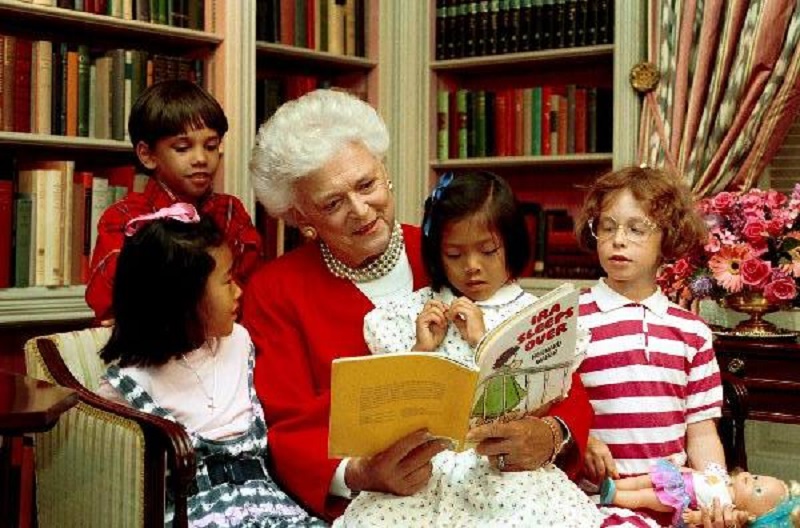
Mrs. Barbara Bush reads to children in the White House Library
The Family of Gottlieb and Eva Demuth
Gottlieb Demuth first lived in Frederick Township and the Saucon Valley. As was already mentioned, he married Eva Barbara GutsIer (1713-1784), either in 1739 or May 1740. She was a widow of Henry Hehl. Two children from her first marriage died.
According to Neisser’s List, Gottlieb and Eva Demuth had seven sons, four of whom died early, and two daughters. The name of their first son, who must have died as an infant, is not known with certainty (18). The second son, Tobias, was born in 1741 in Saucon, two miles from Bethlehem, where the young couple lived at the time.
After moving to Bethlehem, Gottlieb and Eva had two more sons, Johannes (1743-45) and Gottlieb (1745-46), who died young and were buried at the Old Moravian Cemetery in Bethlehem.
There is a record of Tobias Demuth, identified as a son of Gottlieb, as having attended the Moravian School in Fredericktown in 1745, where Gottlieb Demuth was then employed. Two additional children were born to the Demuths in Fredericktown, Anna Maria (1746-1813) and Joseph (1748-1827). The latter is buried in the Moravian Graveyard at Nazareth.
When Fredericktown School was discontinued, the Demuths and several other families moved to a Moravian settlement at Allemaengel in Lynn Township, Lehigh County. Gottlieb and his wife Eva Demuth were listed as members of the Moravian Church in Allemaengel in 1754, according to Rev. Abraham Reincke’s “Register”. While in Allemaengel, three more children were born to them, Gottlieb (1750-1825), Christopher (1755-1822), and Regina (1757-?).
During the Indian war the family had to flee from Allemaengel to Plainfield. They were among the first members of Schoeneck, where they subsequently moved. Gottlieb Demuth died at Schoeneck on October 6, 1776 at the age of sixty-one.
After the death of her husband, the widow made her home with her youngest son Christopher. She died at Schoeneck, May 20, 1784 at the age of seventy-one.
According to Gottlieb’s Last Will (20), five of his children were living at that time, namely, Anna Maria, Joseph, Gottlieb, Christopher and Rosina. It is noteworthy that all three surviving sons, Joseph (1748-1827), Gottlieb Jr. (1750-1825) and Christopher (1755-1822) actively participated in the Revolutionary War, all having been enrolled in the Second Battalion of the Northampton County, PA Militia.
Gottlieb Demuth, Jr. and Christopher Demuth later moved to Ohio in Tuscarawas County where they left a great number of descendants, many of whom are living today.
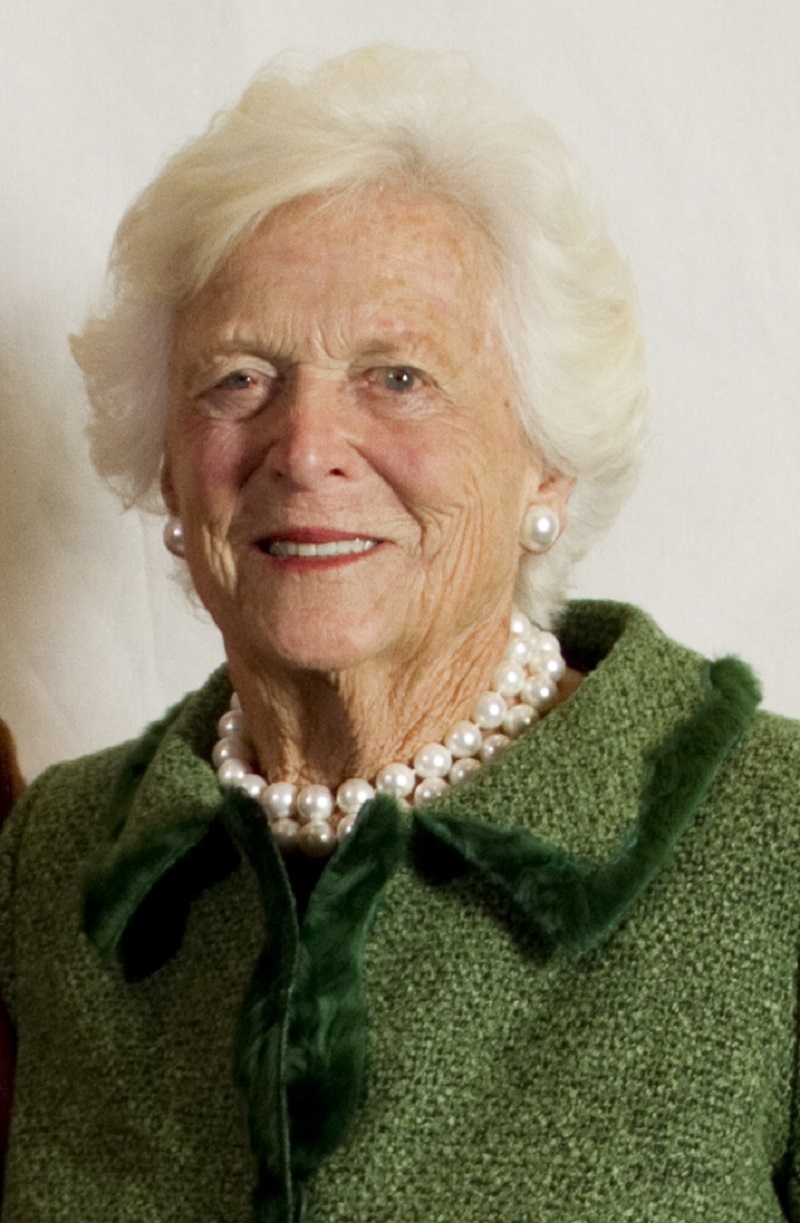
The Roots of the First Lady Barbara Pierce Bush
That Barbara Pierce Bush (1925-), the wife of the former President George H. W. Bush (1924-), and the mother of the current President George W. Bush (1946-), is of Czech descent, I reported earlier and also posted her family tree on the Internet. (19). It was also published in the periodical Kosmas (20) and as a chapter in Rechcigl’s monograph Czechs and Slovaks in America (21).
The First Lady is a descendant of Gottlieb Demuth (1715-1776), a native of Karlov in Bohemia, who immigrated to America in 1736. Besides two sons and two daughters, his wife Eva Barbara Gutsler gave birth to another son, named Christopher on August 22, 1755 in Allemangel, Pennsylvania, where the family lived at that time. In 1777, the mentioned Christopher (1755-1823) married Susanna Catherine Klein (1758-1817) and owned land in the vicinity of Shoeneck and Nazareth. He and his brother Gottlieb took part in the American Revolutionary War in Pennsylvania militia, under the command of Captain Jacob Heller. Their names appear on the memorial monument in the Gnadenhutten cemetery, Ohio, where the brothers moved.
Christopher and Susanna Catherine Klein had altogether 10 children, two sons and eight daughters. Of these, Margaret Demuth (1793-1850) married John Flickinger (1787-1824) on April 7, 1812. Soon after, the War of 1812 started during which the State of Ohio was exposed to constant attacks by the Indians. John Flickinger served in the militia at that time. Even though John did not belong to the Moravian church, the names of his first four children can be found in the Moravian Church registry in Gnadenhutten and Beersheba. Their youngest son Stephen Flickinger (1823-1869), from whom Barbara Bush descended, was born on May 4, 1823. Soon after he was born, the family was stricken by a misfortune when John Flickinger died at an early age of 37 years, leaving the young widow with six children, ranging in age from 1 to10. A year later, Margaret married James Tracy (1799-1889).
Stephen Flickinger married Margaret A. Figley with whom he had 7 children. He died also relatively young at the age of 45 on January 22, 1869, leaving the widow with so many children to take care of. Their son Jacob Marion Flickinger (1849-1917) married Sarah A. Haines (1855-1888). They had one daughter together, whom they named Lula Dell. Sarah died also very young, in 1888, at the age of 33 years.
Lula Dell Flickinger (1875-1957) married on March 31, 1895 James Edgar Robinson (1868-1932), the son of the Justice of the Ohio Supreme Court. They had four children: Pauline, Sarah, Eloise and James. Based on the Robinson’s family tradition, they were all members of the Presbyterian Church.
Their daughter Pauline was a student at Miami University in Oxford, Ohio, where she met her future husband Marvin Pierce (1893-1969), whom she married in 1918. They then removed to New York where Pierce worked for the McCall’s Publishing Co., of which he later became director.
Their daughter Barbara, the future First Lady of the United States, was born on June 8, 1925 in the city of Rye, New York. She married the future President George Herbert Walker Bush (1924-) in 1945. Their first son George Walker Bush was born on June 6, 1946. At the time of his birth, his parents lived in New Haven, Connecticut, where George Bush was a student at Yale University.
Barbara Bush’s mother, Pauline Robinson died in an automobile accident in 1949, at the time when Barbara was pregnant with her second child. Their second child was a daughter Robin who died prematurely at the age of three on leukemia. Afterwards four more children were born, including John Ellis “Jeb” Bush, the former Governor of Florida.
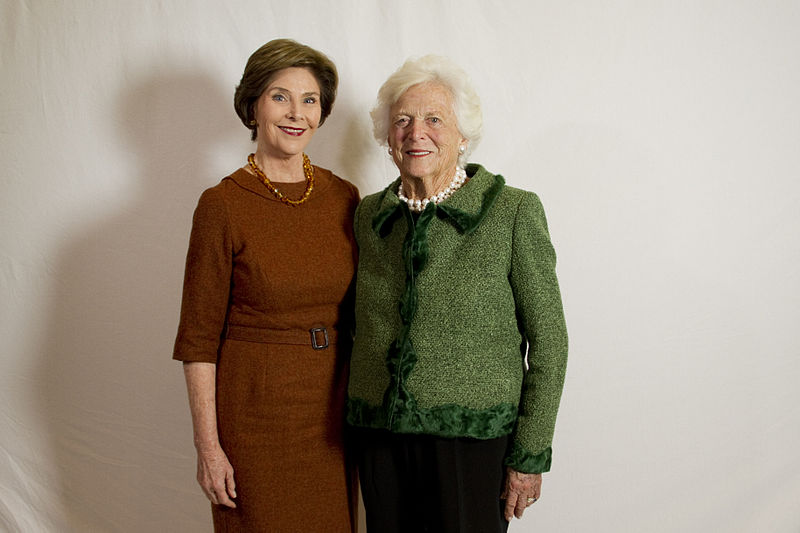
Former First Ladies: Mrs. Barbara Bush and Mrs. Laura Bush at the LBJ Presidential Library in 2012.
END NOTES
- These were followers of the teachings of the Czech religious reformer and martyr John Hus and the spiritual heirs of Bohemian Brethren who found temporary refuge in Moravia and later in Upper Lusatia on the estate of Count Nicholas Ludwig von Zinzendorf. For more information on the history of the Church, see Edmund de Schweinitz’s The History Church Known as the Unitas Fratrum (Bethlehem, 1885); J. Mueller, “O souvislosti obnovené církve bratrské se starou Jednotou bratří českých” (The Connection of the Renewed Brethren Church, with the Ancient Unity of Bohemian Brethren), Časopis Musea království českého 59 (1885), pp.193-210; J. Taylor Hamilton, History of the Moravian Church 1722-1957 (Bethlehem, 1967).
- Harry Martin Klein, “Henry Cornelius Demuth,” in: Lancaster County, Pennsylvania. A History, Vol. 3 (New York-Chicago: Lewis Historical Publishing Co., 1924), pp. 208-209.
- “Demuth; Henry C., Manufacturer, Enterprising Citizen,” in: Encyclopedia of Pennsylvania Biography (New York: Lewis Historical Publishing Co., 1932), Vol. 6, pp. 2058-2060.
- Mrs. John E. Malone, “Charles Demuth,” Papers of the Lancaster County Historical Society 52, No. l (1948), pp. 1-18.
- Farnam,.Emily; Charles Demuth. Behind a Laughing Mask (Norman: University of Oklahoma Press, 1971)
- Charles B. Galbraeth, “Oliver J. Demuth” in: History of Ohio (Chicago-New York: American Historical Society, 1925), Vol. 3, pp. 165-l66.
- C. F. Battershell, The Demuth Family and the Moravian Church (New Philadelphia, OH: July 1931).
- Genealogy of the Demuth Family Printed by W. T. Van Vleck, Sec’y of the Demuth Association, Gnadenhütten, OH). Compiled by the Rev. Th. Müeller, Archivist of the Records of the Moravian Church in Herrnhut, Saxony.
- Anna E. Gray and Donald S. Gray, Demuth Family Tree 1650-1941 (New Philadelphia, OH, July 1961).
- Sarah Davies Hogeboom, Sweet their Memories Are. A Genealogical Journal. A Book One (Madison, WI, n.d.).
- Albert H. Frank, “George Neisser. An Early Moravian Historian,” Transactions of the Moravian Historical Society 23, part 2 (1977), pp. 1-11.
- For complete references to the sources used, see Sources below.
- Retrospektivní lexikon obcí Československé socialistické republiky 1850-1970 (Retrospective Gazetteer of the Communities of the Czechoslovak Socialist Republic 1850-1970) (Praha: Federální statistický úřad, 1978).
- Battershell and other American genealogists had assumed that this was a boy by name of Justine. Based on Neisser’s and Moeschler’s records, we are fairly certain that Justina, as the name was supposed to be spelled, was a girl.
- For a good description of the “Hidden Seed,” see Adolf Vacovský’s article, “History of the Hidden Seed (1620-1722)”, in: Unitas Fratrum – Moravian Studies. Edited by Mari P. Van Buijtenen, Comelis Dekker and Huib Lceuwenberg (Rijksarchief in Utrecht, 1975), pp. 35-54.
- His name might have been James, as we read in The Bethlehem Diary 1742-1744 (1971) that on Wednesday, January 30, 1743 “Gottlieb Demuth moved to Nazareth with his wife and child, and also the little James.”
- This can be translated as “Utter Destitution.”
- “Demuth, Godlike, Yeoman “Aged,” Schoeneck, Bethlehem Township,” in: Abstracts of Wills. Northampton Co., PA. – The fact that the will includes only one Christoph and does not mention Christian further substantiates the conclusion that Christoph Demuth (1738- 1818) and Christian Demuth (1740-1781) were children of Gotthard Demuth rather than Gottlieb’s.
- Miloslav Rechcigl, Jr.,” Czech Roots of Barbara Pierce Bush,” click here.
- Miloslav Rechcigl, Jr., “The Moravian and Moravian Roots of President Bush and His Contender for U.S. Presidency Senator Kerry,” Kosmas 19, No. 1 (Fall 2005), pp. 69-74.
- Miloslav Rechcigl, Jr., Czechs and Slovaks in America. Surveys, Essays, Reflections and Personal Insights relating to the History and the Contributions of Czech and Slovak Immigrants in America and their Descendants. Boulder, CO: East European Monographs and New York: Columbia University Press, 1955), pp. 259-277.
Sources
A List of the Bohemian and Moravian Emigrants to Saxony. Collected from various sources in Print and Manuscript; Begun and Completed at New York from June 2 to July 20, 1772. By George Neisser. Translated and Edited by Albert G. Rau, Ph.D. Bethlehem, Penn.: Times Publishing Company, 1913. Reprinted in: Transactions of the Moravian Historical Society, Vol. 9, Parts 3 and 4.
A History of the Beginning of Moravian Work in America. Being a Translation of George Neisser’s Manuscripts by Rev. William N. Schwarze, Ph.D., D.D. and Rt. Rev. Samuel H. Gapp, Ph.D., D.D. with Extensive Biographical and Historical Notes by the Rt. Rev. S. H. Gapp (Bethlehem: The Archives of the Moravian Church, 1955).
“Annals of Early Moravian Settlement in Georgia and Pennsylvania.” Extracted chiefly from George Neisser’s Compilation, a MS in the Archives at Bethlehem. In: Memorials of the Moravian Church. Edited by William C. Reichel. Vol. I (Philadelphia: J.B. Lippincott and Co., 1870), pp. 157-187.
Levering, Joseph Mortimer, A History of Bethlehem. Pennsylvania. 1741-1892. With Some Account of its Founders and their Early Activity in America (Bethlehem, PA: Times Publishing Co., 1903).
The Bethlehem Diary. Vol. 1. 1742-1744. Translated and Edited by Kenneth G. Hamilton (Bethlehem, PA: The Archives of the Moravian Church, 1971).
A Register of Members of the Moravian Church and of Persons Attached to Said Church in this Country and abroad between 1727-1754. Transcribed from a MS in the handwriting of the Rev. Abraham Reincke, to be found in the Archives of the Moravian Church at Bethlehem, and illustrated with historical annotations by W.C. Reichel. In: Transactions of the Moravian Historical Society, Vol. 1 (1876), pp. 283-426.
“Burial Book of the Moravian Church, Lancaster, 1744-1821,” Pennsylvania Vital Records (Baltimore: Genealogical Publishing Co., 1983), Vol. 1. pp. 389-429.
“Eighteenth Century Vital Records from the Early Registers of the Moravian Congregation at Schoeneck, Northampton County, Pennsylvania.” Compiled by Charles M. Sandwick. Easton. PA: Jacobsburg Historical Society, 1978.
Kluge, Edw. T., The Moravian Graveyards at Nazareth, Pa.. 1744-1904. Reprinted in: Transactions of the Moravian Historical Society, Vol. 7. 1906, pp. 83-207.
Schultze, August, The Old Moravian Cemetery of Bethlehem, Pa.. 1742-1897. Reprinted in: Transactions of the Moravian Historical Society, Vol. 5. 1879, pp. 97-294.
Beck, Abraham Reincke, The Moravian Graveyards of Lititz, Pa., 1744-1905. Reprinted in: Transactions of the Moravian Historical Society, Vol.7, 1906. pp. 215-236.
“Marriage Register of the Moravian Church, 1742-1800,” Pennsylvania Archives, Ser. 22. Vol. 9 (1896), pp. 107-158.
Fries. Adelaide L., The Moravians in Georgia 1735-1740 (Raleigh, N.C.: Edwards and Broughton, 1905).
Moeschler, Felix, Alte Herrnhuter Familien (Herrnhut: Missionbuchhandlung, 1922-1924). 2 vols.
Jordan, John W., “Moravian Immigration in Pennsylvania 1734-1765,” Pennsylvania Magazine of History and Biography 33 (1909), pp. 228-248.
Říčan, Gustav, “O starém Ochranově” (Old Herrnhut), Křesťanská revue 39 (1972), pp. 136-141.
Images: WikiMedia Commons
Guest Post Author

Mila Rechcígl
Miloslav Rechcígl, Jr. is one of the founders and past Presidents of many years of the Czechoslovak Society of Arts and Sciences (SVU), an international professional organization based in Washington, DC. He is a native of Mladá Boleslav, Czechoslovakia, who has lived in the US since 1950.
Read his entire profile here. Discover Mila’s many books on Amazon.
If you have not already subscribed to get TresBohemes.com delivered to your inbox, please use the form below now so you never miss another post.
Remember, we rely solely on your donations to keep the project going.
Become a friend and get our lovely Czech postcard pack.


